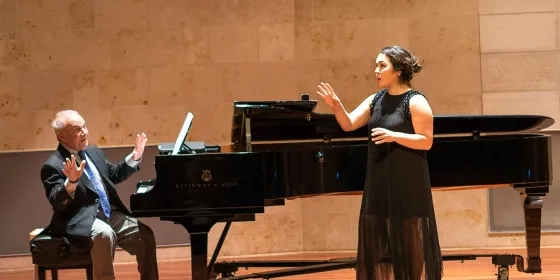Martin Katz in for Ten Artist-in-Residence Visits in 2020-21
Hailed by the New York Times as “the gold standard of accompanists” Martin Katz’s list of frequent collaborators reads as a who’s-who of opera stars: Marilyn Horne, Frederica von Stade, Kathleen Battle, Kiri Te Kanawa, Cecilia Bartoli, and Jose Carreras, to name a few. Now, vocal performance students at the San Francisco Conservatory of Music will have ample opportunity to glean his wisdom.
“Martin Katz is one the finest collaborative pianist working today,” says Dean and Chief Academic Officer Jonas Wright. “Studying with Katz is an amazing opportunity for our vocal students, and we are thrilled to welcome him as Artist-in-Residence for the 2020-21 school year.”
The world-renowned collaborative pianist, conductor, and educator has previously visited SFCM for weeklong residencies and masterclasses, and will now become an even more familiar face around campus. “Over the course of the full academic year, Professor Katz will visit a generous 10 times,” says Wright. “He brings his experience of more than 40 years of collaborating with many of the world’s greatest artists here to the halls of SFCM and its students. We could not be more excited!”
A born collaborator, Katz found early on that he worked best with others. “When you study piano as a child, you’re playing by yourself. Then, that first time that you play with somebody else, you either love it or you hate it.” That answer was clear to Katz, even as he began his undergraduate studies in piano performance at age 16. “I didn’t get any kick from playing solos,” he says. “By sophomore year, I was already accompanying people. And by the time I was a junior, I wasn’t playing solos at all. And that was fine with everybody, because there weren’t that many people who loved [accompanying].”
In his five-decade career, Katz has not only performed with and coached some of opera’s biggest names, but has also recorded for some of its biggest labels: RCA, CBS, BMG, EMI, Decca. In addition, he’s a longtime faculty member of the University of Michigan, where he has served as Chair of the Collaborative Piano Department for over thirty years. He also works frequently with (and plays recitals for) students and faculty at the Music Academy of the West, SongFest, Merola Opera Program, and San Francisco Opera’s Adler Fellows.
At SFCM, in his one-hour, one-on-one sessions with students, Katz is able to make a quick assessment of what each student needs to work on. With Katz himself at the piano, time is used even more efficiently. “When I’m playing, I’m already able to show the singer things that I think about the piece--the advantage is that they’re hearing my concept of it from the very beginning,” he says.
With Katz literally setting the tone on the piano, the student can enter the right frame of mind for the piece before he or she sings a note—a necessary skill for any vocalist. Katz continues playing a listening, “making a mental list of what might need to be adjusted--and the things that are great that I want to mention to them!” Adjustments might range from minor tweaks (“Maybe the diction needs help”) to more major overhauls (“Maybe the key needs to be adjusted higher or lower”) to simply finding the right emotional space for the piece.
After all, Katz believes, it’s the feeling behind the singing that matters most, a lesson he tries to impress upon his students. “I think it’s important to remember why you chose to sing,” he says. “Nobody, at age 14 or 15 or whenever, said ‘Oh, I just love technique! I want to study technique!’” Instead, he says, most singers found that spark through a desire to perform and entertain, to express and communicate. “I’m not saying that technique isn’t necessary--it’s essential. But too often it becomes an end, instead of a means to an end. I think that’s a terrible shame. You don’t want to lose that kid inside you who just loves to sing.”
Or, in Katz’s case, to collaborate.
